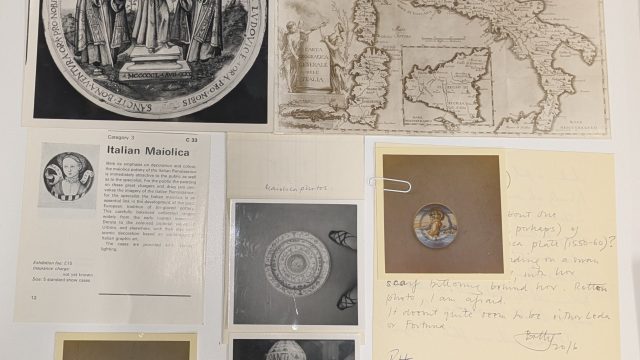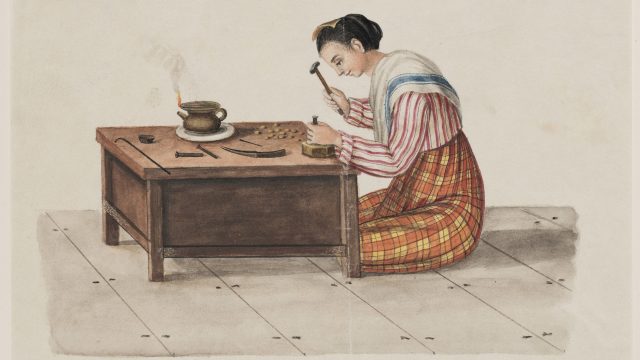Lilia Prier Tisdall
Textile Conservation Display Specialist
The list of costumes to be mounted for the exhibition Ocean Liners: Speed & Style seemed relatively small at 20 ensembles in comparison to some of our main shows, which can feature upwards of 200 textiles. Small, however, certainly does not mean straightforward; it was clear from our first meeting that curator Ghislaine Wood and the exhibition designers from Casson Mann had big ambitions for these historic garments. They wanted all the costumes on display to have been worn on an ocean liner (or presumed to have been), which is why most of them belong to the collections of the American socialite Emilie Grigsby and diplomat Anthony J. Drexel Biddle, both seasoned transatlantic travellers. As such, the textiles in the exhibition not only have the function of showcasing the development of fashion styles in swimwear and evening wear during the early 20th century heyday of the ocean liner, but also of populating and animating the space with a sense of the characters who might have been aboard these ships.
The combined curatorial and design vision was to tell the story of life on board an ocean liner through a series of nautical scenarios including pool, cabin, deck and bar areas, with a central, show-stopping ‘Grande Descente’. To bring these tableaux locations to life we would need highly individualised mannequins in unique poses that interacted with their surroundings. Particularly challenging was the ‘pool’ scene featuring a variety of reclining and seated figures and a striking diving mannequin (Figure 1).
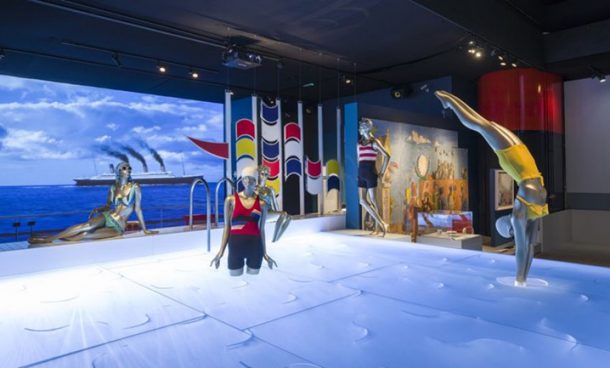
‘Dramatic’ mannequins of this kind can run the risk of waxwork creepiness as attempts at life-like poses can appear awkward when frozen in time and space. This is the costume mounter’s constant conundrum: how to breathe life into inanimate garments when mounting them on inanimate mannequins. Clothes are designed to be worn by living bodies that walk, sit, swim and even dive. Mannequins, by contrast, stay still. With this design brief in mind it might have seemed that ordering bespoke mannequins for each garment was the only option, which is extremely costly as well as time-consuming. However, we were able to achieve the majority of the desired poses using off-the-shelf mannequins, with a few simple but innovative adaptations.
One major success where conservation requirements and design vision came together was the mounting of a 1920s beaded Lanvin dress worn by Emilie Grigsby (T.151&A-1967). Although mounted temporarily for photography on an upright dress form, the inherent fragility of this garment, constructed of glass beads embroidered onto silk chiffon, meant that this was inconceivable for long-term display. Usually these types of dresses have to be displayed flat on a board but this would not fit with the ambition that the fashion bring a sense of life and character to the exhibition.
A compromise was found in the idea of a seated pose, which would support most of the weight of the dress as well as show it on a full-figure mannequin. As the dress has a narrow slim-fitting inner slip, the question then became how to achieve this seated position without the mannequin sitting on the dress. Working with technician Matt Rose, we were able to adapt an off-the-shelf mannequin in a seated position from a previous exhibition, developing a cantilevered system that allows the mannequin to hover 5cm above the seat (Figure 2). First a square aluminum plate (12mm thick) was riveted and screwed to the underside of the mannequin to ensure a secure fixing method to the mannequin. To this was attached a steel bar (30mm wide, 5mm thick) bent at a stepped right angle to follow the bend in the legs. This steel bar was then attached to the fabric-covered display seat, 5cm clear of the top of the seat. This left enough room for a padded board to be inserted beneath the mannequin to fully support the lower part of the dress, which could be carefully pulled round and under to its natural hem line at the back of the knee. Extra padding and a tight stretch jersey cover give additional support to the beaded fabric of the dress.
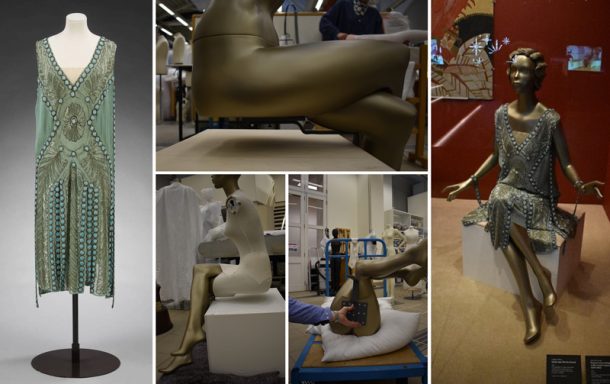
Mounting some of the skimpier swimwear in the exhibition required a similar degree of ingenuity and attention. One example is a 1960s Pucci bikini (Private Lender) that was destined for a glamorous reclining poolside figure. The bikini top, cut like a bodice with a lace-up front, would not sit correctly on the ample bosom of the mannequin due to the smooth surface of the fiberglass. To provide a surface with a bit more grip that would hold the bikini top in place, as well as provide a barrier layer between the textile and the fibreglass, it was necessary to create a very tight jersey cover, cut away so as not be visible. This cover needed to be held in place invisibly, resulting in some intricate architectural rigging using a combination of stitched cotton tape, rivets on the shoulders and clear nylon thread across the bust. Finally, discreet 10mm plastazote blocks were used to ensure the mannequin would not put weight on the bikini itself (Figure 3).
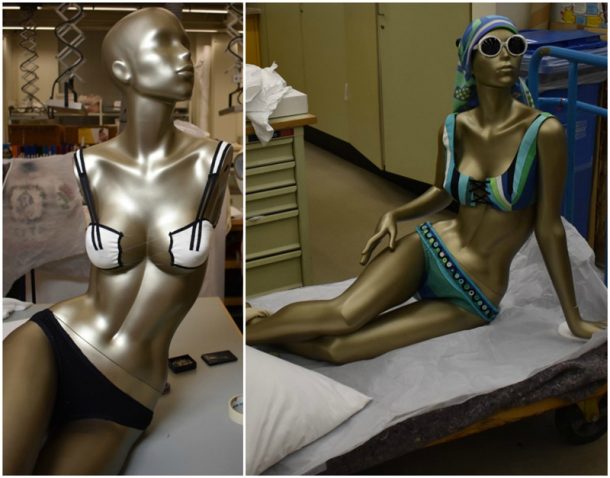
For the ‘Grande Descente’ section of the exhibition the designers were keen to take the idea of bringing garments to life one step further by creating a Duchamp-inspired film installation that captures the theatrical dazzle of the moment when passengers would descend from their cabins to dinner, showing off their latest eveningwear styles. The result is a dramatic combination of mannequins and audio/visual where replica garments worn by a living actress morph into static mannequins walking down a stepped display plinth (Figure 4) https://www.vam.ac.uk/articles/making-an-entrance-ocean-liner-style . Once again, we were lucky to source the majority of these poses off-the-shelf, with only Mr Biddle’s tailcoat (T.134:1 to 13-2015) requiring adapted legs and poseable wire arms. While most exhibition-goers will have little inkling of such behind-the-scenes efforts, here in the Textile Conservation Studio we are quietly proud of the contribution we have made to keeping Ocean Liners looking shipshape.
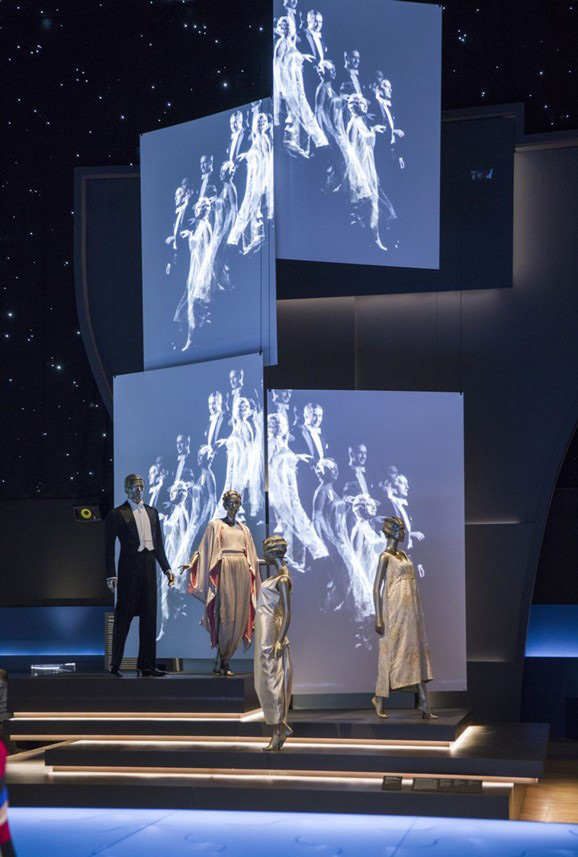
Acknowledgements
I am grateful to V&A Museum Technician Matt Rose and V&A Textile Conservator Elizabeth-Anne Haldane for their collaboration in the mounting of Ocean Liners Speed & Style. I am also grateful to Proportion>London and Doyenne for their help sourcing, selecting and adapting the mannequins used in the exhibition.
Ocean Liners: Speed and Style is sponsored by Viking Cruises and runs until 17 June 2018.
